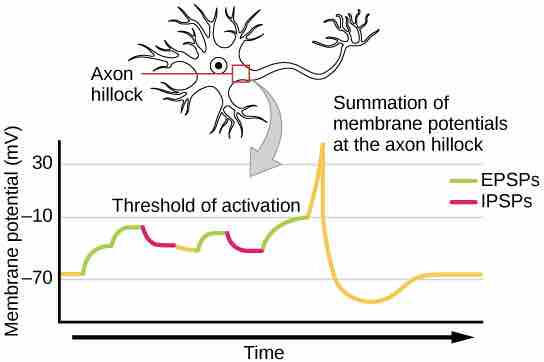Signal Summation
Each neuron connects with numerous other neurons, often receiving multiple impulses from them. Sometimes, a single excitatory postsynaptic potential (EPSP) is strong enough to induce an action potential in the postsynaptic neuron, but often multiple presynaptic inputs must create EPSPs around the same time for the postsynaptic neuron to be sufficiently depolarized to fire an action potential. Summation, either spatial or temporal, is the addition of these impulses at the axon hillock . Together, synaptic summation and the threshold for excitation act as a filter so that random "noise" in the system is not transmitted as important information.

Signal summation at the axon hillock
A single neuron can receive both excitatory and inhibitory inputs from multiple neurons. All these inputs are added together at the axon hillock. If the EPSPs are strong enough to overcome the IPSPs and reach the threshold of excitation, the neuron will fire.
One neuron often has input from many presynaptic neurons, whether excitatory or inhibitory; therefore, inhibitory postsynaptic potentials (IPSPs) can cancel out EPSPs and vice versa. The net change in postsynaptic membrane voltage determines whether the postsynaptic cell has reached its threshold of excitation needed to fire an action potential. If the neuron only receives excitatory impulses, it will also generate an action potential. However, if the neuron receives as many inhibitory as excitatory impulses, the inhibition cancels out the excitation and the nerve impulse will stop there. Spatial summation means that the effects of impulses received at different places on the neuron add up so that the neuron may fire when such impulses are received simultaneously, even if each impulse on its own would not be sufficient to cause firing. Temporal summation means that the effects of impulses received at the same place can add up if the impulses are received in close temporal succession. Thus, the neuron may fire when multiple impulses are received, even if each impulse on its own would not be sufficient to cause firing.